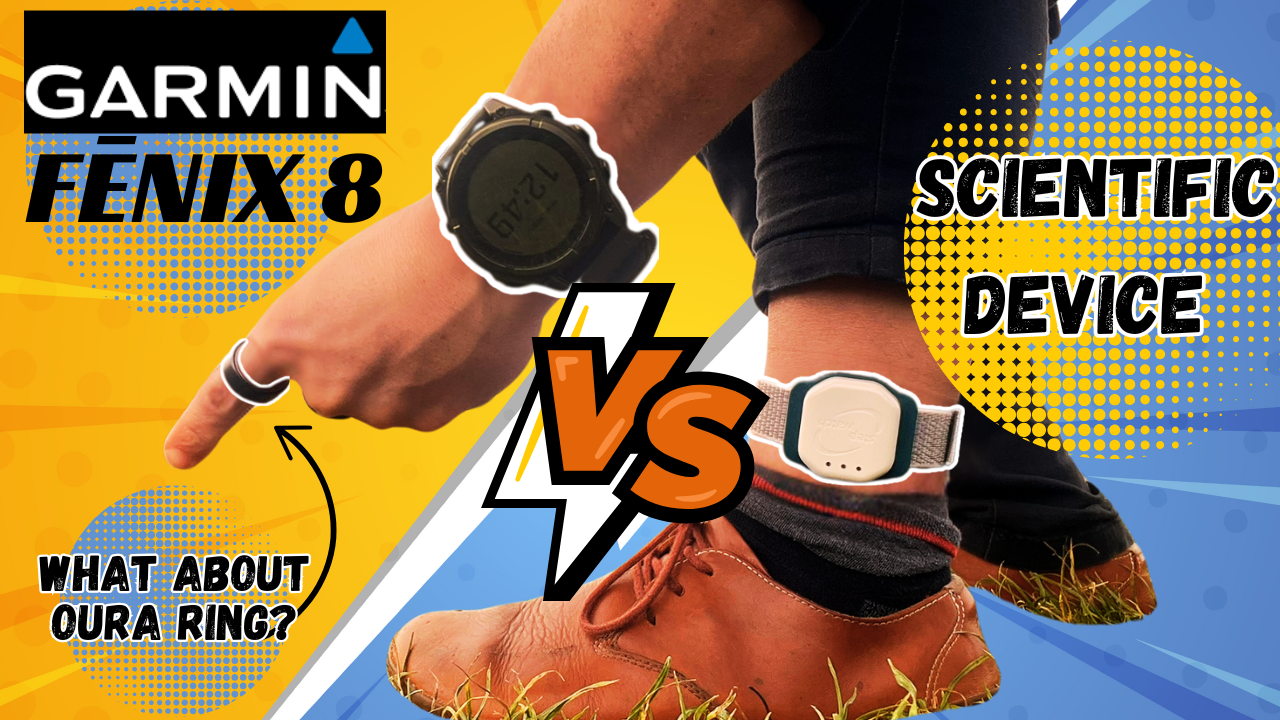Smart Ring Oura Gen 4 vs. Smart Watch Garmin Fenix 8: Step Tracking Accuracy 🚶
Garmin's top-tier watch, the new Fenix 8, vs. the scientific step-tracking device Modus StepWatch 5 vs smart ring Oura Gen 4.

From time to time, I hear someone say, "My XY watch tracks steps poorly." I ask, "How do you know?" And the reply is, "It measures completely differently than my YZ watch." 🤦♂️
I decided to dig deeper into this issue. And we're starting with the Garmin Fenix 8 & Oura Gen 4.
🔎 What Are We Examining? STEPS!
Steps are the fundamental unit of movement we perform while walking or running. They are sequential movements of the legs, where one leg moves forward, followed by the other, with the body supported by one or both legs.

Simple, right? Or maybe not?
💕 Why Are Steps So Popular?
Steps are a fantastic metric for several reasons:
- 🏃♂️ Simple and Understandable – Everyone knows the legendary "10,000 steps a day." It's an easy-to-remember, motivating goal.
- 📱 Easily Measured – Steps are a basic metric for almost all wearable devices. Whether you have a smartwatch, a smart ring, or just a phone in your pocket, you’ll always get a number giving you a rough idea of your activity level.
- 📊 Great for Comparison – You can compare them with yesterday, last week, or even how many steps your spouse or colleague managed today.
- 🕒 Happening All the Time – Steps occur naturally throughout the day unless you’re sitting still. No need to focus on a specific sport – steps are with you from morning to evening.
- 🏅 Motivational – With achievable goals and challenges like "meet your daily step count," steps encourage you to keep moving.
📐 Measuring vs. Estimating
The Garmin Fenix 8 multisport smartwatch is a versatile device that tells you everything from how much deep sleep you got, your VO2 Max, Body Battery, to your stress levels.
However, these results are estimates calculated by algorithms based on raw data measurements. For example, the amount of deep sleep is estimated using data from:
- Accelerometer (body movements during the night)
- Optical heart rate sensor (heart rate and its variability).
⌚ Garmin Fenix 8 & Steps
To stay precise, it’s fair to say that the Garmin Fenix 8 estimates steps based on data from its accelerometer. This means the device uses algorithms to filter out hand movements that aren’t associated with actual steps.
When you think about it, deciphering steps from wrist movements isn’t a simple task. There are plenty of situations where detecting steps is nearly impossible—typically when your hands are in a static position, like pushing a stroller, carrying a load, or holding a phone to your ear.
🥼 Reference Device
As a reference device, I chose the best available option: a "bracelet" worn above the ankle, known as the Modus StepWatch 5.

Validated in over 600 scientific studies, it delivers highly reliable data, even for individuals with irregular or slow walking patterns.
Its accuracy is approximately 99%, with a deviation of ±1.5%, making it ideal for precise step tracking, even in challenging conditions.

🧪 Weekly Test
For one week, I carefully wore:
- StepWatch 5 🔴 (reference device) on my left ankle
- Garmin Fenix 8 🟢 on my left wrist
How did it turn out?

From my perspective, the results were quite surprising:
- 🔻 Garmin underestimated steps, contrary to what I initially expected.
- ➕ It turns out that I actually walk more steps in reality than I thought.
- 📈 Garmin’s correlation was 0.805, indicating a strong positive relationship between the two curves, i.e., the estimates from both devices.
- The correlation would have been even higher (specifically 0.993) if not for November 27, 2024. What happened that day? I walked a lot, but in an unusual way—I was walking on a treadmill, with my hands mostly static on the desk.
- 🚨 The average absolute deviation is 5,487 steps. That’s quite significant—half of the "standard" 10k daily goal.
- The percentage deviation is 33.31%.
Conclusion
Sometimes, I feel we overestimate what wearable electronics on our wrists and fingers can provide. Many people would be surprised by how large the deviation from reality can be for something as seemingly simple as step counting.
On the other hand, the correlation is very strong. So, in practical terms, I don’t consider it critical if your watch reports 4,000 fewer steps—what matters most is that the difference is consistent.
I’ll continue measuring. I currently wear the Garmin Fenix 8 24/7, and I acquired the StepWatch 5 primarily as a reference device for testing data accuracy in smart rings.
Once I have more data, I’ll share it!




